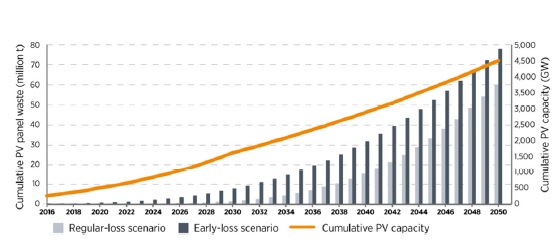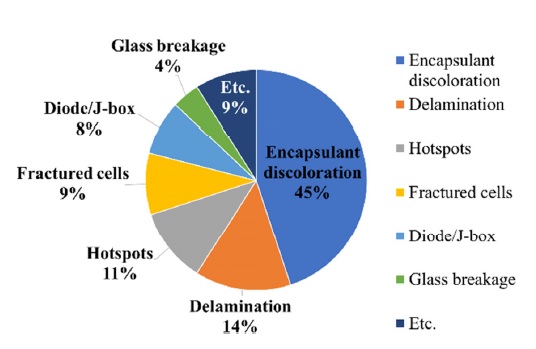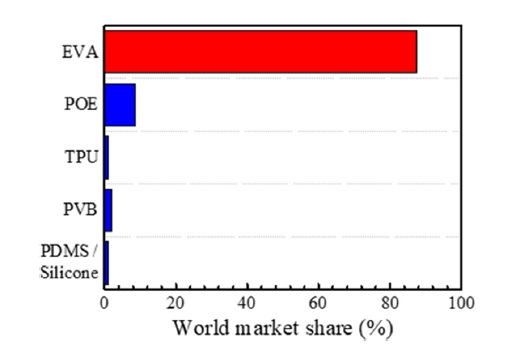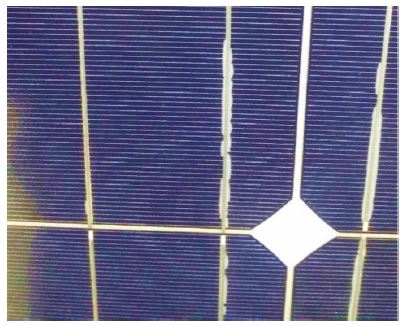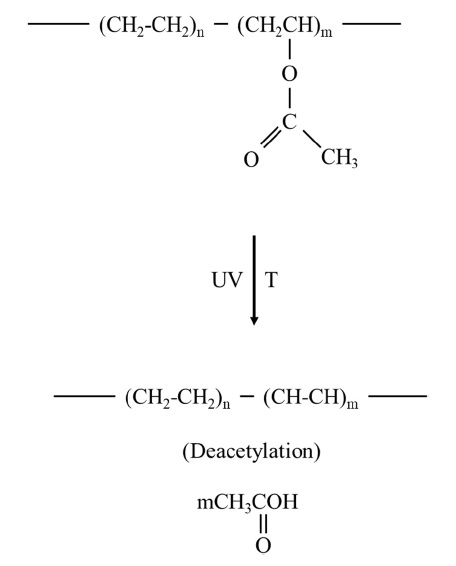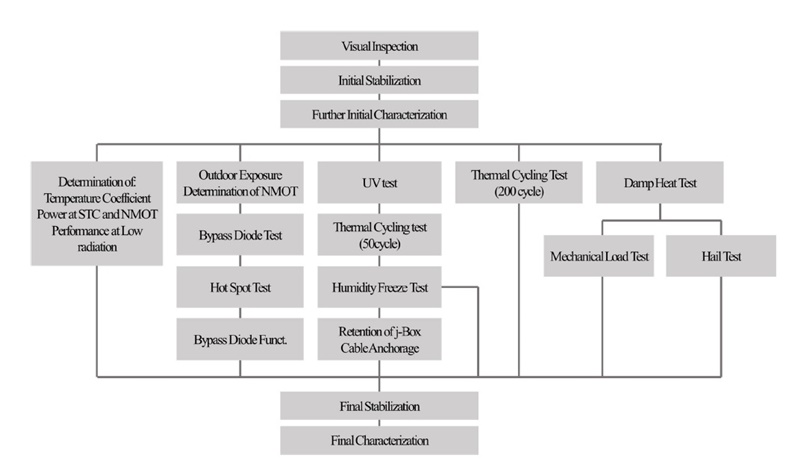
Online publication date 12 May 2021
Investigation of EVA Accelerated Degradation Test for Silicon Photovoltaic Modules
Copyright © 2021 by the New & Renewable Energy
This is an Open Access article distributed under the terms of the Creative Commons Attribution Non-Commercial License (http://creativecommons.org/licenses/by-nc/3.0) which permits unrestricted non-commercial use, distribution, and reproduction in any medium, provided the original work is properly cited.
Abstract
Renewable energy has become more popular with the increase in the use of solar power. Consequently, the disposal of defective and old solar panels is gradually increasing giving rise to a new problem. Furthermore, the efficiency and power output decreases with aging. Researchers worldwide are engaged in solving this problem by developing eco-module technologies that restore and reuse the solar panels according to the defect types rather than simple disposal. The eco-module technology not only solves the environmental problem, but also has economic advantages, such as extending the module life. Replacement of encapsulants contributes to a major portion of the module maintenance plan, as the degradation of encapsulants accounts for 60% of the problems found in modules over the past years. However, the current International Electrotechnical Commission (IEC) standard testing was designed for the commercialization of solar modules. As the problem caused by long-term use is not considered, this method is not suitable for the quality assurance evaluation of the eco-module. Therefore, to design a new accelerated test, this paper provides an overview of EVA degradation and comparison with the IEC and accelerated tests.
Keywords:
Silicon PV module, Eco module, Encapsulant, EVA, Degradation, Accelerated test1. Introduction
The amount of waste panels is gradually increasing, and the generation of waste panels in the future is expected to increase substantially due to the end of active panels and the evolution of new PV panels.
In Fig. 1, the growth starts with 5% in 2020 (i.e. annual waste of 220,000 ton compared to 5 million ton in new installations). However, it increases over time to 4~14% in 2030 and 80~89% in 2050. In 2050, 5.5~6 million tons of PV panel waste is predicted in comparison to 7 million tons in new PV panel installations.[1]
Supplied solar modules are certified by the International Electrotechnical Commission (IEC) standards. However, even in modules that have been certified through the IEC test, many problems are constantly found and has to be discarded before the end of the warranty period.
The main failure modes found in silicon solar modules are corrosion, delamination, discoloration, cracks, and breakages. According to data reported by NREL in 2017, the most common degradation mode in modules used up to now was encapsulant discoloration (45%) followed by delamination (14%), hotspots (11%), fractured cell (9%), diode, and junction box (8%), and glass breakage (4%). It can be seen that encapsulant discoloration and delamination are major problems accounting for 60% of the total failure modes. Thus, it is not practical to consider that the increase in waste panels can be prevented by planning an experiment to analyze only encapsulant degradation, which is one of the most common problems in recent times.[2]
The encapsulant serves as structural support, electrical isolation, physical isolation, and physical protection from external harmful environmental factors for the solar module.[3] In addition, to allow sunlight penetration into the solar cell, the encapsulant is made of a transparent polymer. Materials used as encapsulants include EVA, POE, TPU, PVB, PDMS, and silicone, among which EVA is the dominant encapsulant in PV applications due to its low cost and high thermal stability.[4,5] Figure 3 shows the percentage of world market share in 2020 in each of the different material categories.[6]
In order to design an accelerated test to evaluate the solar modules, it is necessary to analyze the degradation of the encapsulant, which is a major part of degradation, especially EVA, which is used most. Therefore, in this paper, we intend to summarize the research trends by reviewing the types, causes, and test methods of EVA degradation and to suggest future research plans.
2. EVA Degradation
2.1 Delamination
Encapsulant delamination can be divided into encapsulation-glass delamination, encapsulation-cell delamination, and encapsulant-backsheet delamination. The type that occurs mainly is encapsulation-cell delamination. Delamination occurs when EVA loses its adhesive strength under high humidity and high temperature conditions, especially around the ribbon.[7,8] Delamination is critical to reliability and lifetime as it increases the moisture penetration path and exposes the cell to moisture, accelerating cell corrosion and power loss.[9] Delamination resistance can be analyzed through adhesion measurements, and adhesion loss can be calculated after stress is applied. This analysis found that the UVAbs (ultraviolet absorber) additive accelerates the exfoliation process.[10]
2.2 Discoloration (Browning)
The main cause of power loss in crystalline silicon PV modules is the reduction of short circuit current. One of the mechanisms that can reduce short-circuit current in this way is the discoloration of the encapsulant.[11] Specialized Technology Resources, Inc. (STR, formerly Springborn Laboratories) reported that the observed EVA discoloration was the most severe in modules deployed in areas with high operating temperatures and high irradiation.[12] According to the study of G. Oreski et al., the main cause of discoloration is UV radiation and moisture exposure combined with temperatures above 50℃ which cause changes in the chemical structure of the polymer.[13] UV light below 360 nm generates free radicals in the presence of oxygen which cause photothermal degradation of polymers.[14] The photothermal degradation of EVA eliminate acetic acid which are the responsible chromophores for discoloration.[15] The degradation reactions of EVA are shown in Fig. 5.[14] In general, the discoloration of EVA proceeds from light yellow to dark brown and follows a sigmoidal pattern.[16] If discoloration proceeds, it prevents the absorption of solar power, causing power loss, and the heat dissipation is not smooth which makes the operating temperature rise, accelerating the degradation. Since discoloration accelerates in a sigmoidal pattern until the critical point is reached, it is expected that long-term life expectancy can be predicted by analyzing the initial degradation rate and finding the threshold point.
3. IEC Test
IEC 61215 specifies the requirements for design qualification and type approval of crystalline silicon modules for operation in general outdoor climates. IEC 61215 divides tests as shown in the figure and proceeds sequentially. Among them, the tests that can affect the encapsulant are damp-heat test, humidity freeze test, thermal cycling test, and UV test, and each test condition is in Table 1.
This is insufficient time for evaluation of long-term use of solar modules. It is necessary to extend the test time to proceed with certification or to redesign the test in consideration of conditions that can accelerate degradation.
4. EVA Accelerated Test Method and Analysis
4.1 Damp Heat Test and Humidity Freeze Test
Moisture is well known to cause problems with polymers and adhesions. In particular, EVA has a high moisture absorption rate, so moisture stability is poor.[17]
Commercial product EVA has been found delamination considerably from glass substrates after prolonged immersion in an 85℃ water bath or exposure to damp heat.[18] F. J. Pern et al. reported the mechanisms for enhanced EVA adhesion during damp heat exposure are attributed to follows: (1) An increase in the siloxane bonding density via the smaller silane molecules of cross-linking vinyl or dipodal silanes, (2) a presence of hydrophobic fluorosilane, (3) a dominant use of vinyl benzyl silane (with vinyl and hydrophobic benzyl), and/or (4) a presence of low-concentration aminosilane serving as a catalyst.[18] The mechanism of damp heat degradation in the paper reported by Xu-Ming Shi et al. shows that acetic acid is generated as a by-product.[19] Acetic acid can accelerate degradation because it promotes corrosion. According to a study by C. Peike et al., as a result of the damp heat test for 2,000 hours at 80℃ and 90℃, it was confirmed that the series resistance increased and the slope of VOC decreased due to grid corrosion by delamination occurring only at 90℃.[20] Although the test was conducted twice as long as the IEC test, degradation did not occur at 80℃, and only at 90℃. It can be seen that the condition of IEC test, 1,000 hours at 85℃, may not be sufficient for the degradation.
Humidity Freeze Test (HF) endures a DH condition (85℃, 85% RH) for 20 hours, then cool down the temperature cycle lasting 4 hours to -40℃ and rises back to + 85℃. A sequence of 10 cycles (10 days) is required to meet IEC 61215 requirements.[21] However, according to J.I. Hanoka et al.’s paper, there is no noticeable power drops even after 75 HF cycles.[22] This test result also shows that the IEC test is insufficient for analysis of degradation for long-term use.
In order to test delamination, it is necessary to provide moisture, maintain a high temperature for a long time, or repeat the cycle many times with various temperature conditions.
4.2 Thermal Cycling Test
Thermal cycling tests are usually conducted to check for broken interconnects, broken cells, solder bond failures, junction box adhesion, and module connection failures.[23] However John H. Wohlgemuth analyzed the I-V measurement after conducting the thermal cycling test, and found that Pmax decreased due to the decrease of ISC. [24] As a result of the thermal cycling test repeated 550 cycles from - 40℃ to 90℃ using a mini module, Pmax decreased from 34.6 W to 26.6 W, but FF and VOC hardly changed, and only Isc decreased from 7.39 A to 6.2 A. They concluded that transmittance decreases due to the discoloration of EVA after thermal cycling, resulting in a decrease in current.
The last IEC test (2005) did not match the results in the outdoor environment. So, the updated Standard IEC test (2016) has provisions for UV preconditioning prior to thermal cycling and humidity freeze test. According to M. Gagliardi's study, the module that simulated the thermal cycling test after UV exposure showed more pronounced EVA photolysis than the module that simulated without UV exposure.[25] Results revealed that the decisive cause of EVA photolysis was UV exposure. And it can be seen that conducting an experiment by combining temperature and UV was a more desirable research direction as it obtained similar results to the actual environment.
4.3 UV Test
The UV test is for analysis polymer problems such as delamination of encapsulant, encapsulant loss of adhesion and elasticity, encapsulant discoloration, and ground fault due to backsheet degradation. According to the IEC standard test, a total of 15 kWh/m2 of radiation is irradiated using a UV source of 280~385 nm at 60 ± 5℃. Accelerated tests have been projected to withstand for 25 years or more under various conditions. These conditions are set by some parameters such as UV dose, materials, and temperature are considered as variables.
According to a previous study, it can be seen that degradation is promoted as the UV dose increases.[26,27] In addition, through the study of Vincent Guiheneuf et al., it was confirmed that even if irradiance is different, if the total UV dose is the same, the degree of degradation is similar.[28] Therefore, the degradation test can be accelerated by increasing the UV irradiance.
It was confirmed that the power decreases as the temperature increases during the UV test, and in the study of M.A. Mikofski et al., it was proved that the transmittance of EVA decreased as the temperature increased during the UV test.[29,30] That is indicated that the discoloration of EVA accelerated in a hightemperature environment and that it was the cause of the decrease in output power.
The IEC test has only 4~6 acceleration factors by continuous exposure, but the accelerated test can be designed with a larger acceleration factor by controlling the UV dose and temperature. The acceleration factor according to irradiance is calculated by comparison with 35.30 W/m2, the UV dose corresponding to 280~385 nm, which is the ultraviolet region of AM 1.5 G.[31] And the acceleration factor according to the temperature is calculated by the ISC reduction ratio of each temperature, in comparison with the result at 60℃, which is the condition of the IEC test. Table 1 shows the total acceleration factor calculated by multiplying the median value of the acceleration factor according to continuous exposure, the acceleration factor according to irradiance, and the acceleration factor according to temperature.
If the test is designed by controlling UV irradiance and temperature, long-term life expectancy can be predicted in a short period of time. However, if the acceleration factor is set too large, it may show a difference from the actual result. Therefore, it is necessary that design the test by considering the acceleration factor and similarity with the actual result.
5. Conclusion
In order to solve the problem of increasing waste panels, we have focussed at the encapsulation material, especially EVA, which is one of the parts to be studied intensively in the module technology. According to previous studies, the main causes of EVA degradation are known as moisture, heat, and UV. Specifically, it was confirmed that moisture causes delamination, and UV cause discoloration. However, through several studies, it can be seen that the conditions and test time of the IEC test are insufficient to confirm and analyze the degradation. To compensate for this, it is necessary to add conditions that can accelerate the test or increase the test time. The discoloration due to UV, which is the cause of the decrease in output power, can be accelerated by temperature and irradiance. By controlling each variable and increasing the acceleration factor, long-term life expectancy can be predicted in a short time. However, to design an accelerated test for the application to an eco-module, a more accurate prediction of degradation and lifetime will be possible by designing the test and analyzing it under conditions similar to the outdoor environment of each region. Therefore, future research should be designed to enable long-term analysis in short time by combining each acceleration factor affecting the acceleration test and considering the similarity with the results in the actual outdoor environment.
Subscript
| EVA : | ethylene vinyl acetate |
| PV : | photovoltaic |
| IEC : | international electrotechnical commission |
| NREL : | national renewable energy laboratory |
| PID : | potential induced degradation |
| POE : | polyolefin |
| TPU : | thermoplastic polyurethane |
| PVB : | polyvinyl butyral |
| PDMS : | polydimethyl silicone |
| UV : | ultraviolet |
| UVAbs : | ultraviolet absorber |
| STR : | specialized technology resources, inc. |
| DH : | damp heat |
| HF : | humidity freeze |
| RH : | relative humidity |
| ISC : | short circuit current |
| VOC : | open circuit voltage |
| Pmax : | maximum power |
| FF : | fill factor |
Acknowledgments
This research was supported by grants from the New & Renewable Energy Technology Development Program of the Korea Institute of Energy Technology Evaluation and Planning (KETEP) funded by the Korean Ministry of Trade, Industry and Energy (MOTIE) (Project No. 20203030010060 and 20194010000090).
References
-
Weckend, S., Wade, A., and Heath, G., 2016, “End-of-life management: Solar photovoltaic panels”, IRENA, pp. 32.
[https://doi.org/10.2172/1561525]

-
Jordan, D. C., Silverman, T. J., Wohlgemuth, J. H., Kurtz, S. R., and VanSant, K. T., 2017, “Photovoltaic failure and degradation modes”, Prog. Photovolt: Res. Appl., 25(4), 318-326.
[https://doi.org/10.1002/pip.2866]

-
Kempe, M., 2011, “Overview of sientific issues involved in selection of polymers for PV applications”, Proceedings of the 2011 37th IEEE Photovoltaic Specialists Conference, pp. 000085-000090.
[https://doi.org/10.1109/PVSC.2011.6185851]

-
Sinha, A., Sastry, O.S., and Gupta, R., 2016, “Nondestructive characterization of encapsulant discoloration effects in crystalline-silicon PV modules”, Sol. Energy Mater. Sol. Cells, 155, 234-242.
[https://doi.org/10.1016/j.solmat.2016.06.019]

-
Cznderna, A.W., and Pern, F.J., 1996, “Encapsulation of PV modules using ethylene vinyl acetate copolymer as a pottant: A critical review”, Sol. Energy Mater. Sol. Cells, 43(2), 101-181.
[https://doi.org/10.1016/0927-0248(95)00150-6]

- Fischer, M., 2020, “ITRPV 11th edition, April 2020 report presentation and key findings”, ITRPV, pp. 21.
-
Gxasheka, A.R., van Dyk, E.E., and Meyer, E.L., 2005, “Evaluation of performance parameters of PV modules deployed outdoors”, Renew. Energy, 30(4), 611-620.
[https://doi.org/10.1016/j.renene.2004.06.005]

-
Wohlgemuth, J.H., Hacke, P., Bosco, N., Miller, D.C., Kempe, M.D., and Kurtz, S.R., 2016, “Assessing the cuases of encapsulant delamination in PV modules”, Proceedings of the 2016 IEEE 43rd Photovoltaic Specialists Conference, pp. 0248-0254.
[https://doi.org/10.1109/PVSC.2016.7749589]

-
Park, N.C., Jeong, J.S., Kang, B.J., and Kim, D.H., 2013, “The effect of encapsulant discoloration and delamination on the electrical characteristics of photovoltaic module”, Microelectronics Reliab., 53(9-11), 1818-1822.
[https://doi.org/10.1016/j.microrel.2013.07.062]

-
Jentsch, A., Eichhorn, K.-J., and Voit, B., 2015, “Influence of typical stabilizers on the aging behavior of EVA foils for photovoltaic applications during artificial UV-weathering”, Polym.Test., 44, 242-247.
[https://doi.org/10.1016/j.polymertesting.2015.03.022]

-
Wohlgemuth, J. H., Kempe, M.D., and Miller, D.C., 2013, “Discoloration of PV encapsulant”, Proceedings of the 2013 IEEE 39th Photovoltaic Specialists Conference, pp. 3260-3265.
[https://doi.org/10.1109/PVSC.2013.6745147]

- Holey, W.W., and Agro, S.C., 1998, “Advanced EVA-based encapsulants”, NREL/SR-520-25296.
-
Oreski, G., and Walner, G.M., 2009, “Evaluation of the aging behavior of ethylene copolymer films for solar applications under accelerated weathering conditions”, Sol. Energy, 83, 1040-1047.
[https://doi.org/10.1016/j.solener.2009.01.009]

-
Pern, F.J., 1997, “Ethylene-vinyl acetate (EVA) encapsulants for photovoltaic modules: degradation and discoloration mechanisms and formulation modifications for improved photostability”, Angew. Makromol. Chem., 252(1), 195-216.
[https://doi.org/10.1002/apmc.1997.052520114]

-
Pern, F.J., and Czanderna, A.W., 1992, “Characterization of ethylene vinyl acetate (EVA) encapsulant: Effects of thermal processing and weathering degradation on its discoloration”, Sol. Energy Mater. Sol. Cells, 25(1-2), 3-23.
[https://doi.org/10.1016/0927-0248(92)90013-F]

-
Pern, F.J., 1996, “Factors that affect the EVA encapsulant discoloration rate upon accelerated exposure”, Sol. Energy Mater. Sol. Cells, 41-42, 587-615.
[https://doi.org/10.1016/0927-0248(95)00128-X]

-
Mclntosch, K. R., Powell, N. E., Norris, A. W., Cotsell, J. N., and Ketola, B. M., 2011, “The effect of damp-heat and UV aging tests on the optical properties of silicone and EVA encapsulants”, Prog. Photovolt: Res. Appl., 19(3), 294-300.
[https://doi.org/10.1002/pip.1025]

- Pern, F. J., and Jorgensen, G. J., 2005, “Enhanced adhesion of EVA laminates to primed glass substrates subjected to damp heat exposure”, Proceedings of the 31st IEEE Photovoltaic Specialists Conference, pp. 495-498.
-
Shi, X.-M., Zhang, J., Li, D.-R., and Chen, S. J., 2009, “Effect of damp-heat aging on the structures and properties of ethylene-vinyl acetate copolymers with different vinyl acetate contents”, J. Appl. Polym. Sci., 112(4), 2358-2365.
[https://doi.org/10.1002/app.29659]

-
Peike, C., Hoffman, S., Hulsmann, P., Thaidigsmann, B., Weiss, K.A., Koehl, M., and Bentz, P., 2013, “Origin of damp-heat induced cell degradation”, Sol. Energy Mater. Sol. Cells, 116, 49-54.
[https://doi.org/10.1016/j.solmat.2013.03.022]

-
Hulsmann, P., and Weiss, K.-A., 2015, “Simulation of water ingress into PV-modules: IEC-testing versus outdoor exposure” Sol. Energy, 115, 347-353.
[https://doi.org/10.1016/j.solener.2015.03.007]

- Hanoka, J.I., 2002, “Accelerated testing of an encapsulant for PV modules”, Conference Record of the Twenty-Ninth IEEE Photovoltaic Specialists Conference, pp. 1565-1567.
-
Wohlgemuth, J.H., and Kurtz, S., 2011, “Reliability testing beyond qualification as a key component in photovoltaic’s progress toward grid parity”, Proceedings of the International Reliability Physics Symposium, IRPS11-551.
[https://doi.org/10.1109/IRPS.2011.5784534]

- Wohlgemuth, J. H., and Petersen, R. C., 1993, “Reliability of EVA modules”, Conference Record of the Twenty Third IEEE Photovoltaic Specialists Conference, pp. 1090-1094.
-
Gagliardi, M., and Paggi, M., 2018, “Long-term EVA degradation simulation: Climatic zones comparison and possible revision of accelerated tests”, Sol. Energy, 159, 882-897.
[https://doi.org/10.1016/j.solener.2017.10.081]

-
Jiang, X., He, W., Yang, J., Chen, C., Yang, H., Wang, H., Li, H., and Dong, Y., 2018, “Study on UV Induced EVA Discoloration for Crystalline Silicon Solar Modules”, Proceedings of the IEEE 7th World Conference on Photovoltaic Energy Conversion (WCPEC), pp. 1282-1285.
[https://doi.org/10.1109/PVSC.2018.8547677]

-
Wang, H., Wang, A., Yang, H., Zhang, J., and Huang, J., 2016, “Performance degradation of crystalline silicon solar module in various ultraviolet radiation area”, Proceedings of the IEEE 43rd Photovoltaic Specialists Conference (PVSC), pp. 1757-1760.
[https://doi.org/10.1109/PVSC.2016.7749925]

-
Guiheneuf, V., Delaeux, F., Pouliquen, S., Riou, O., Logerais, P.-O., and Curastanti, J.-F., 2017, “Effects of the irradiance intensity during UV accelerated aging test on unencapsulated silicon solar cells”, Sol. Energy, 157, 477-485.
[https://doi.org/10.1016/j.solener.2017.08.044]

-
Gopalakrishna, H., Sinha, A., Dolia, K., Jordan, D., and Tamizhmani, G., 2019, “Nondestructive Characterization and Accelerated UV Testing of Browned Field-Aged PV Modules”, IEEE J. Photovolt., 9(6), 1733-1740.
[https://doi.org/10.1109/JPHOTOV.2019.2927920]

-
Mikofski, M.A., Kavulak, D.F.J., Okawa, D., Shen, Y., Terao, A., Anderson, M., Caldwell, S., Kim, D., Boitnott, N., Castro, J., Smith, L.A., Lacerda, R., Benjamin, D., and Hasselbrink Jr, E.F., 2012, “PVLife: An Integrated Model for Predicting PV Performance Degradation over 25+ Years”, Proceedings of the 2012 38th IEEE Photovoltaic Specialists Conference, pp. 001744-001749.
[https://doi.org/10.1109/PVSC.2012.6317932]

-
Kempe, M.D., 2010, “Ultraviolet light test and evaluation methods for encapsulants of photovoltaic modules”, Sol. Energy Mater. Sol. Cells, 94(2), 246-253.
[https://doi.org/10.1016/j.solmat.2009.09.009]


